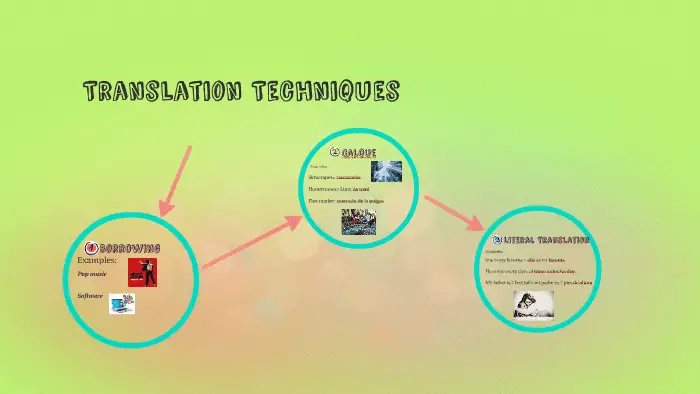
What Are Translation Techniques?
Translation techniques are used when structural and conceptual elements of the source language can be transposed into the target language: Borrowing: taking words straight into another language, also known as ‘transfer’
https://www.youtube.com/watch?v=ceOGbyAlJag
Why Do We Need To Employ Different Translation Techniques?
- Translation techniques enable effective communication between people around the world. It is a courier for the transmission of knowledge, a protector of cultural heritage, and essential to the development of a global economy. Highly skilled translators are keys help practitioners develop those skills.
- When a professional translator sits down to work, he or she does not stop and think about the strategies to be employed for particular translation work. It comes spontaneously. But ask a translator to make a list of the translation techniques they use and they might be hard-pressed to describe these to an outsider. Nevertheless, I will pinpoint these techniques to help readers interested in translation to learn more about the many nuances of this interesting work that well deserves public awareness and attention.
- A translator considers many elements before the actual translation is done. There could be discrepancies in vocabulary and grammar in both languages that means literal translation is not possible. That is why these translation techniques are used to come up with an accurate translation.
- Broadly, there are two main translation types: direct and oblique, with sub-types under each one. It should be noted that translation techniques are different from translation methods. Translation methods are applied to the entire document. Translation technique, on the other hand, can vary within the same document, based on the particular verbal elements that require translation.
What Are The Different Translation Techniques?
Direct Translation Techniques
- Direct translation techniques are utilized when the conceptual and structural elements of the source language (SL) are directly transferable into the target language (TL). The techniques used for direct translation are borrowing, calque and literal translation.
- In borrowing, the words are taken directly from the source language into the target language without any translation, such as funk, technology, abattoir, passé, café, résumé, hamburger and bandana. Often, these words are italicized to indicate that they are foreign words.
- Also known as loan translation, it means a phrase that is borrowed from another language and literally translated, such as “superman” and “beer garden” from the German words and. The German “standpunkt” becomes “standpoint” in English. Calques can be seen often in international and specialized fields, such as “quality assurance” or “aseguramiento de calidad” in Spanish. The meanings of some calques are not that clear to other people, especially when they relate to law, science and other vocations. Often the translator will be creating coined words in the target language by adopting the source language’s structure, as in “handball” (English) becoming “balonmano” in Spanish. “Rascacielos” (Spanish) and “gratte-ciel” (French) means skyscraper in English.
- Literal translation. Word-for-word or literal translation (metaphrase) is applicable to some languages but not for others due to the difference in the structure of the sentences. For example, in the English sentence, “The team is working to finish the report,” the literal translation in Spanish is “El equipo está trabajando para terminar el informe.” But this sentence cannot be literally translated into German or French because of the differences in sentence structure. It is normally applied only to languages that are very close to each other culturally and is only acceptable if the same syntax, style, and meaning are maintained in the translated text.
Oblique Translation Techniques
When the conceptual or structural elements of the source language cannot be directly translated into the target language without changing its stylistic and grammatical elements and the meaning, oblique translation techniques are used. Here, the translator exerts tighter and stricter control over their translation. This category has five types:
- In modulation, a phrase that is not the same as the SL and TL is used to impart the same idea. The Spanish phrase, “te lo dejo” literally translates to “I’ll leave it to you.” However, it sounds better when translated as “you can have it.” It changes the meaning and switches the source language’s point of view. Modulation can also be used without changing the meaning and putting an awkwardness in the target language. It is also possible to employ modulation in the same language. In this example, “es fácil de entender” and “no es complicado de entender” mean “it is easy to understand” and “it is not complicated to understand,” respectively. The former indicates that something is not difficult to comprehend, whereas, in the latter, the meaning goes deeper by saying that something was previously thought of as difficult, but turns out to be not a complicated thing to understand.
- This is when the sequence of some parts of the speech changes, for example, “yellow ball” in English becomes “balle jaune” in French. This is because grammatical structures could be different in some languages, e.g., “Er schwimmt gern” in German is “he likes swimming” in English. Transposition is also employed often when translating English into Spanish and vice versa because of verb positioning. In Spanish, the verb is positioned near the end of the sentence while in English, the verb is quite close to the beginning, thus the translator must know that a word category can be replaced in the TL without changing the SL’s meaning.
- Equivalence or reformulation. When translating advertising slogans, interjections, proverbs, names of institutions, and idioms, oftentimes the expression must be translated in an entirely different manner. In this case, equivalence or reformulation is used. This process is a bit difficult and creativity is essential. For example, it is easy for Americans and other English speakers to understand the saying “don’t put all your eggs in one basket.” However, directly translating this phrase might not have the same meaning in other languages, thus substituting it with the phrase; “keep your options open” makes it easier to understand in more languages.
- Generally speaking, compensation applies to terms that cannot be translated yet their nuances are expressed somewhere else within the text. In English, there is only the pronoun “you,” for example, whereas there are informal and formal versions in French (tu and vous), in German (du and sie) and in Spanish (tú and usted). The degree of formality is expressed in several ways, which is not present in English. When using compensation, the translator exercises discretion and some freedom in replacing elements that are inherent in the source language with items that are native to the target language. A translator who uses compensation techniques must have a deeper knowledge of the source and target languages, as well as the ability to have a higher level of understanding that goes beyond literal translation.
- This is used when a term or phrase that is specific to culture is translated in a completely different manner so that it becomes appropriate or familiar to another culture’s language. In adaptation, the cultural reference to a situation is changed if this is not existent in the target culture, like substituting Belgian jokes with Irish jokes when translating from French to English. It is quite commonly used in the translation of movie titles and books as well as in pop culture.
Conclusion
- Have you ever tried to use an online translator and did not understand the resultant translation? If this has happened to you, you will understand the difficult task of coming up with a fully comprehensible and accurate translation in the language that you understand and the fact that human translators are needed to produce quality translations.
- Professional translators employ many elements, skills, knowledge, and techniques that are available and required in their profession. One of the main things is the deep understanding of the source and target languages. Many of the techniques discussed here will be applied in different parts of the document. Literal translation may still need a bit of tweaking to make it sound better in the translated language; verbs may be repositioned and idioms may have to be changed or replaced to fit the culture of the reader. Translators are very sensitive to cultural issues and exercise sound judgment to change phrases, terms, and sentences that might be offensive to other cultures.
- When you require accurate translation, do not rely on machines, as they are not capable of producing accurate translations. Translation work is a combination of many elements. The work process is difficult and long and must conform to various rules, which are indigenous to most languages. For example, English to Spanish translation might not need a lot of changes to be implemented although it cannot be said that it is still easy, consider translation from English to Arabic, English to Hindi, English to Afrikaans or English to Chinese and vice versa. Being a good translator is not an inherent skill; it requires long periods of study and on-the-job experience.







